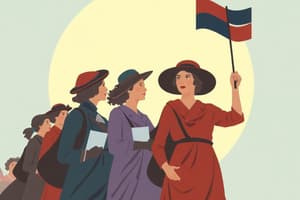Podcast
Questions and Answers
Who were some of the prominent figures in the Women's Suffrage Movement?
Who were some of the prominent figures in the Women's Suffrage Movement?
- Amelia Earhart, Jane Austen, and Florence Nightingale
- Malala Yousafzai, Mother Teresa, and Indira Gandhi
- Marie Curie, Rosa Parks, and Margaret Thatcher
- Elizabeth Cady Stanton, Susan B. Anthony, and Alice Paul (correct)
What was the Seneca Falls Convention known for?
What was the Seneca Falls Convention known for?
- The creation of the Declaration of Independence
- The first public demonstration by suffragettes
- The signing of the U.S. Constitution
- The first women's rights convention in the United States (correct)
What was the primary goal of the Women's Suffrage Movement?
What was the primary goal of the Women's Suffrage Movement?
- To secure women's right to own property
- To promote women's participation in sports
- To gain political representation in government (correct)
- To establish women's supremacy over men
Which amendment was a significant step forward for women's suffrage?
Which amendment was a significant step forward for women's suffrage?
What did the Representation of the People Act in 1918 grant to women in the UK?
What did the Representation of the People Act in 1918 grant to women in the UK?
What was the broader impact of the Women's Suffrage Movement?
What was the broader impact of the Women's Suffrage Movement?
What is one of the long-term impacts of the Women's Suffrage Movement?
What is one of the long-term impacts of the Women's Suffrage Movement?
What did the Equal Pay Act of 1963 require?
What did the Equal Pay Act of 1963 require?
Flashcards are hidden until you start studying
Study Notes
Women's Suffrage Movement
The Women's Suffrage Movement, also known as the Women's Suffrage Movement in the United States or the Suffragette Movement in the UK, was a political and social struggle to gain women's right to vote. It began in the 19th century and lasted until the mid-20th century, when most women in the Western world obtained the right to vote. The movement aimed to secure women's suffrage, or the right to vote in elections, and to gain political representation in government.
Key Figures and Events
Some of the most prominent figures in the Women's Suffrage Movement include Elizabeth Cady Stanton, Susan B. Anthony, and Alice Paul. These women and others organized protests, demonstrations, and public events to raise awareness about women's rights and the importance of suffrage. Some key events in the Women's Suffrage Movement include:
-
Seneca Falls Convention: This was the first women's rights convention in the United States, held in 1848. It led to the creation of the Seneca Falls Declaration of Sentiments, a document outlining women's grievances and demands for equality.
-
Women's suffrage amendments: The movement focused on securing women's suffrage through the passage of specific amendments to the U.S. Constitution. The 15th Amendment, which granted the right to vote to African American men, was a significant step forward for women's suffrage.
-
Women's suffrage in the UK: The movement in the UK culminated in the passage of the Representation of the People Act in 1918, which granted women over the age of 30 the right to vote.
Impact of Women's Suffrage
The Women's Suffrage Movement had a profound impact on society, not only by securing the right to vote for women but also by raising awareness about women's rights and equality. The movement laid the groundwork for further progress in women's rights, such as the passage of the Civil Rights Act in 1964, which prohibited discrimination based on sex, as well as the Equal Pay Act of 1963, which required equal pay for men and women performing the same work.
In conclusion, the Women's Suffrage Movement was a significant political and social struggle that led to the achievement of women's suffrage and contributed to the broader fight for women's rights and equality. The movement involved numerous key figures and events, and its impact can still be felt today in the form of increased awareness and progress towards gender equality.
Studying That Suits You
Use AI to generate personalized quizzes and flashcards to suit your learning preferences.




